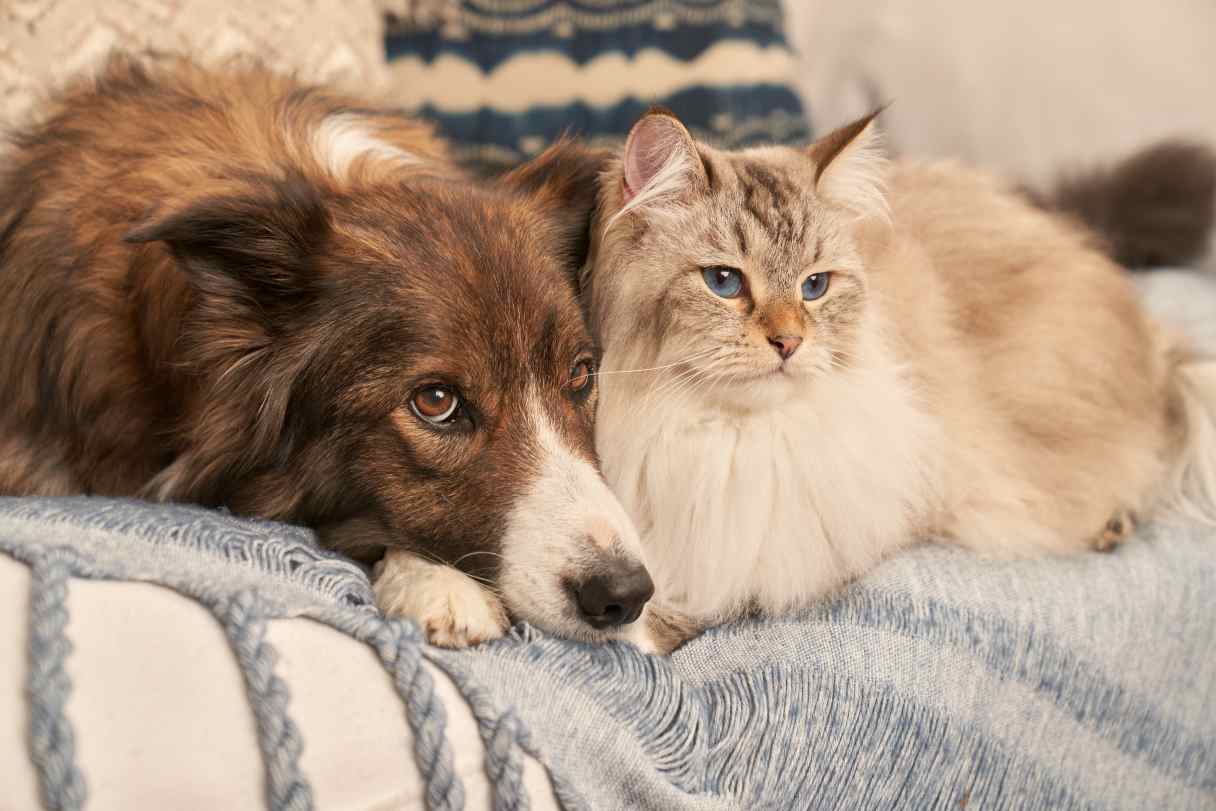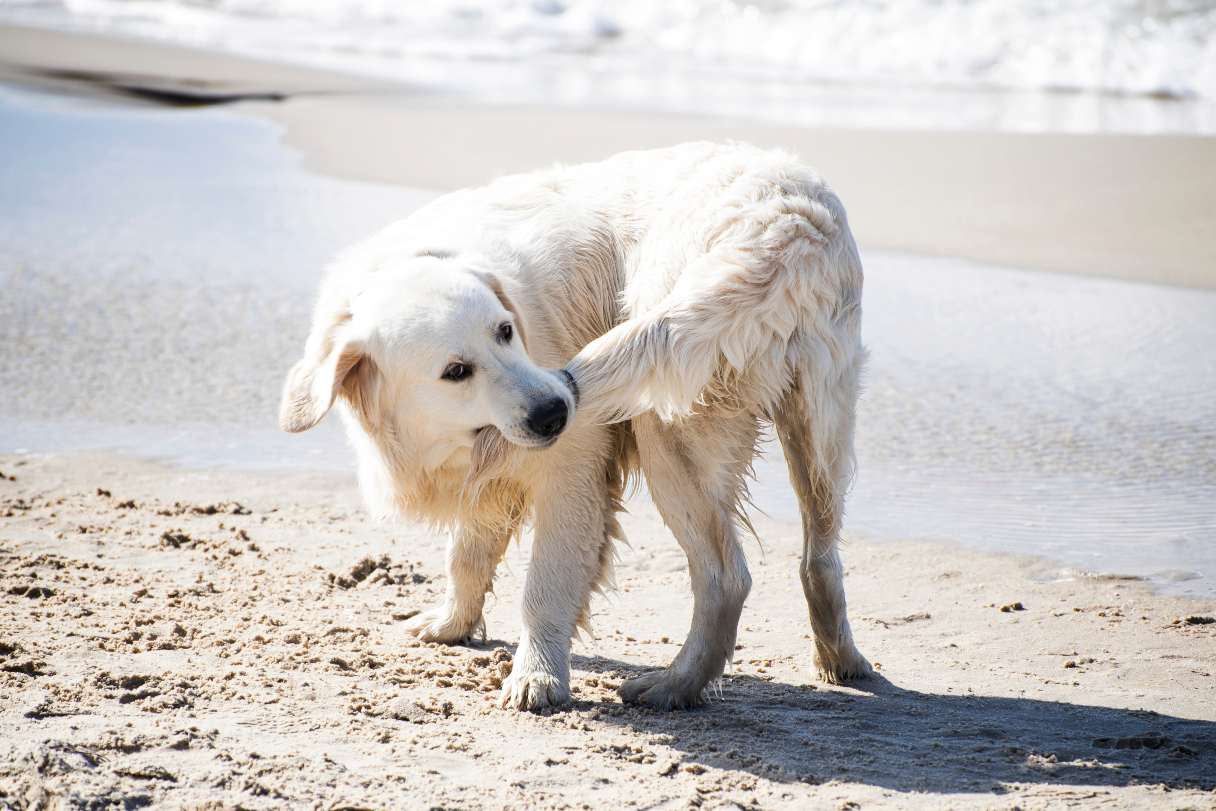You may know from experience that too much stress can be detrimental to both emotional and physical health. This is no less true for your pets. Dogs and cats are sensitive souls who are capable of feeling stress and anxiety just like humans.
To better recognize and help reduce anxiety in your pets, let's look at some of the common causes of stress in dogs and cats, and strategies that may help manage it.
Understand the Types of Stress
Not all stress is the same. Both dogs and cats may experience situational stress, which is a response to something that upsets them.1 This isn’t always a bad thing — for example, it’s appropriate for your pet to act stressed or fearful in the face of illness or legitimate danger.2
But stress that’s disproportionate to the situation is anxiety; and if it happens on a regular basis, it's chronic anxiety, which can result in serious behavioral issues.3
There are three main types of chronic or recurring anxiety in pets:
Age-related anxiety
This is mostly seen in senior dogs and cats who are experiencing cognitive decline. Memory loss and a decline in awareness and perception can cause older pets a lot of confusion, often resulting in anxiety.3
Fear-based anxiety
This is fear and anxiety related to unfamiliar stimuli, such as loud noises like thunder or fireworks, being placed in new situations or environments or encountering strange people or animals. Some pets may recover quickly, but chronically anxious pets can get triggered into fearful and destructive behavior.3
Separation anxiety
Both dogs and cats can experience separation anxiety, which occurs if pets can’t comfort and regulate themselves when they’re alone or separated from their bonded family members.4 This can often result in excessive barking or vocalizing, as well as potentially harmful or destructive behavior.3
Signs Your Dog May Be Stressed or Anxious
Dogs who are stressed or anxious exhibit changes in behavior and body language that can communicate their stress. Some of these behaviors might be normal in the right context, so it’s important to pay attention to body language and behavior when your dog is calm and relaxed so you can tell when something is abnormal.5
These are some common signs of stress in dogs:
Aggression
Fearful or anxious dogs may turn aggressive toward the source of their fear. This can also result in indirect aggression, which is when a dog turns their aggression on a person or another animal that gets between them and the source.3
Warning signs of aggression include aggressive barking or growling.1 This can escalate into snapping and biting if the growling is ignored.6
Avoidance
Just as humans may distract themselves to avoid what’s stressing them out, dogs may find something else to focus on to avoid their stress.2 This might look like refusing to look at or acknowledge the person or thing that’s stressing them or avoiding eye contact.5 Or, they might focus on licking themselves or sniffing the ground.2
Body language
Dogs communicate a lot through their body language, including stress and anxiety. When a dog is stressed, they may display the following changes in their posture or body language:2
-
Cowering
-
Blinking
-
Dilated pupils
-
Drooling
-
Excessive lip licking or smacking5
-
Laying back the ears
-
Panting
-
Raising their hackles5
-
Revealing the whites of their eyes
-
Tucking the tail
-
Yawning
Changes in bodily functions and routines
Dogs may feel an urge to urinate when they’re stressed.2 Anxious and fearful dogs may break their potty training and go inside the house.3 And some dogs may lose control of their bowels altogether.2 Some dogs might also refuse to eat while they’re stressed.2
Destructive behavior
Destructive behavior is especially common in dogs with separation anxiety, often as a result of trying to escape. This might result in chewing and scratching at their crate, or at the floors, walls, drapes or furnishings surrounding doors and windows as they try to escape. Not only is this damaging to property, but it can result in injury to the dog.3
Freezing
Anxious dogs may freeze or go rigid when they see something that causes them stress. This is a sign that your dog is so upset that they can’t handle it, and they've started to mentally and emotionally shut down.5
Hiding
Related to avoidance, some dogs might take avoiding the source of their stress to the extreme of hiding or trying to escape. They might hide behind your legs or pull or nudge you in an attempt to get you to move them away from whatever is upsetting them.2
Pacing
A stressed dog may act restless and pace back and forth, which can signal that something is keeping them from being able to relax. This is often associated with age-related anxiety and may be a sign of dementia. If you notice this behavior in your senior dog, it’s a good idea to talk to your vet.5
Panicking and shaking
Dogs might panic when they’re stressed or scared, becoming frantic. When they can’t get away, they may start shaking or showing other signs of agitation like restless pacing.2
Shedding
When dogs are stressed, they may shed more than usual. You might notice excessive shedding at the vet’s office, in the car on the way to the vet or in any situation where your dog feels stressed out or uncomfortable.2
Vocalizing
Barking and whining aren’t always a sign of stress, but your dog might do either of these more than usual when they’re stressed or upset.2
Dogs who are uncomfortable due to pain or feeling threatened might also growl, which isn’t always meant to be aggressive. Growling is sometimes simply your dog’s way of communicating that they don’t like something. Still, it’s always best to give a growling dog space until they calm down.5
Signs Your Cat May Be Stressed or Anxious
Cats are pretty good at letting you know when they’re angry or upset. Crouching and hissing, swiping with a claw, laying the ears back or arching the back are all familiar signs that your cat is not happy. But anxious or chronically stressed kitties may show other signs that aren’t so obvious, such as:
Appetite changes
Cats who are stressed may lose interest in eating, although others might overeat to self-soothe. Either can be bad for their health, so it’s important to monitor your kitty and talk to your vet if the unhealthy eating patterns persist.7
Changes in litter box habits
If your cat stops using their litter box and starts going outside of it, that could be a sign of stress. However, this could also be a symptom of a health issue, such as a urinary tract infection, so bring it to your vet’s attention if it happens.8
Destructive behavior
Stressed or anxious cats may be more likely to engage in destructive behavior, like scratching the furniture or clawing up the carpet.8
Disinterest
When stressed, your cat might lose interest in playing or other things that they normally enjoy.8
Excessive grooming
Over-grooming is a common sign of stress or anxiety in cats. This excessive behavior can lead to self-harm, often resulting in hair loss and skin lesions.8
Excessive face rubbing
An insecure kitty might become obsessive about rubbing their pheromones on people and objects in order to mark their territory and establish their dominance.8
Hiding
It’s not abnormal for cats to hide in a quiet spot to rest and relax. But if your kitty is hiding more than normal or it takes an unusual amount of effort to coax them out of their hiding spot, it could mean they’re anxious.8
Hypervigilance
Cats who are stressed might seem more on edge than usual, exhibiting hyperawareness of their surroundings. They might get startled easily.8
Gastrointestinal distress
It’s not uncommon for cats who feel stressed to have tummy issues like vomiting, constipation or diarrhea.7
Social changes
When stressed, your normally cuddly cat might act more withdrawn. On the flip side, your aloof cat might become clingy. Either way, changes in how your cat normally interacts with you and other family members can be a sign that something is stressing them out.8
Vocalizing
Meowing more than usual, or crying and yowling, are often signs that something is bothering your cat.7 This behavior is especially common in cats with separation anxiety.4 It can also be a sign of dementia in older cats.9
It’s important to note that many of the signs a cat is stressed can also be symptoms of pain or illness. If you can’t determine an external source of stress, or your kitty’s symptoms persist, you should have them checked out by a vet.
Common Causes of Stress in Pets
In general, anything that your pet sees as a disruption or that makes them feel unsafe or insecure can cause them stress. Here are some common stressors for pets:10
-
Bad experiences with people or other pets
-
Boredom
-
Bullying or aggression from other pets
-
Changes to their environment
-
Disruptions to their routines
-
Isolation
-
Lack of safe and quiet places to sleep and rest
-
Loud noises
-
Moving
-
Negative associations with objects, people, pets or places
-
New people or new pets
-
Owners who are stressed or in a bad mood, or failing to present a calm demeanor5
-
Pain or illness
-
Separation from their people or companion pets
-
Travel
-
Unfamiliar situations
Managing and/or Relieving Your Dog's Stress
The best way to help your stressed dog is to identify and eliminate, as much as possible, the source of their stress.5 If you can’t do that, then remove them from the stressful situation and take them to a safe, quiet place where they can calm down.2
While it may be tempting to comfort your pup right away with treats or cuddles, it’s better to first put them through some obedience commands, which will help distract them and restore a sense of normalcy and security. Taking them for a walk or playing an energetic game with them can also give them a physical outlet for their stress and help them feel calmer.2
You should also check yourself to make sure you’re not the source of their stress. Not only are dogs sensitive to their owner’s moods, but they can become frustrated and stressed when you don’t make it clear what you want from them or if you punish them needlessly. It’s important to remain calm and consistent in training and in establishing and enforcing boundaries with your pet.5
In unavoidable situations, like moving, traveling, going to the vet or bringing home a new family member, you should talk to your vet beforehand about ways to help make it less stressful for your pooch. You should also talk to your vet about possible treatments and interventions for chronic stress and anxiety, or talk to a trainer about ways to reduce or eliminate anxiety triggers.3 And if your pup is showing potential signs of pain or illness, you should have your vet examine them as soon as possible.
Managing and/or Relieving Your Cat's Stress
As with dogs, the best way to help a stressed-out kitty is to either remove or eliminate the source of the stress or remove them from the stressful situation. It’s important to provide your cat with a safe space where they can flee to escape anything that stresses them out. A hidey-hole is good, but cats also like the ability to climb up high to keep an eye on their surroundings. Providing a cat tree or a high shelf they can access easily is a good way to help restore your kitty’s sense of safety and control.8
Here are some other ways to reduce or eliminate triggers and help your stressed-out cat:8
-
Keep their litter box clean and make sure they can access it easily and have plenty of privacy.
-
If you have multiple cats, provide each with their own box.
-
Provide acceptable surfaces for them to scratch.
-
Make sure each kitty has their own food and water bowls, toys and beds so they don’t feel like they have to compete for resources.
-
Play with them and make sure they get plenty of exercise and mental enrichment.
-
Keep their routines as regular as possible whenever changes and disruptions are unavoidable.
-
Respect their temperament and their boundaries, giving space to cats who don’t enjoy pets or cuddles.11
-
Avoid using scented products or air fresheners and fragrances in your home, which can be irritating to cats.11
And again, if your cat is showing physical symptoms, acting like they might be in pain or being chronically anxious, you should take them to the vet.
Early Socialization to Prevent Stress
Both puppies and kittens who are thoroughly socialized are less prone to stress and anxiety when they get older, as well as better able to cope with stressful situations.12 So if you have a puppy or kitten, it’s important to expose them as much as possible to different people, pets, sounds, textures, places and situations. Be sure to keep their social interactions positive, and talk to your vet about safe ways to socialize your youngster before they’re fully vaccinated.13
Stress is often unavoidable, and it’s not even always a bad thing. But when stress negatively affects your pet, it’s important to be able to step in to help them regulate their stress and provide them with reassurance and a sense of security.
Frequently Asked Questions About Stress in Pets
Do you still have questions about stress and anxiety in dogs and cats? Here are some answers to some commonly asked questions on this topic.
CareCredit Credit Card Financing for Dogs and Cats
Taking good care of your pet's well-being from nose to tail is essential. Make sure to stay up to date on their regular checkups at the vet to help keep your pet happy and healthy for a lifetime of love. You can use your CareCredit credit card for pet care throughout the year for routine veterinary services as well as emergencies and surgeries.* Use our Acceptance Locator to find a veterinarian near you that accepts CareCredit.
CareCredit is there for you and your pet every step of the way; continue your wellness journey by downloading the CareCredit Mobile App to manage your account, find a provider on the go and easily access the Well U blog for more great articles, podcasts and videos.
In addition to pet care, you can also use your CareCredit credit card for dentistry, cosmetic, vision, hearing, health systems, dermatology, pharmacy purchases, spa treatments and so much more within the CareCredit network. How will you invest in your health and wellness next?
Author Bio
Jean Marie Bauhaus is a freelance writer and novelist who has been writing pet content since 2013. Her work has appeared on Forbes.com, Hill's Pet, Chewy, AKC.org and more.








